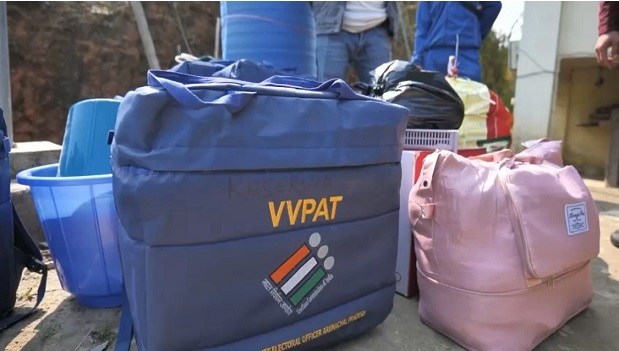Supreme Court also rejects the prayers of petitioners to return to ballot paper voting.


By Nirendra Dev / New Delhi
Supreme Court today rejected all the petitions seeking 100 per cent verification of Electronic Voting Machines (EVMs) votes with their Voter Verifiable Paper Audit Trail (VVPAT) slips.
Supreme Court also ruled that there will be option for candidates to get the microcontroller program of EVMs to be checked by a team of engineers after the declaration of results, such a request is to be made by the candidate within seven days after the declaration of results.
The two-judge bench of Justice Sanjiv Khanna and Justice Dipankar Datta delivered concurrent but separate judgments.
“While balanced perspective is important, blindly doubting a system can breed scepticism and thus, meaningful criticism is needed, be it judiciary, legislature etc. Democracy is all about maintaining harmony and trust among all the pillars. By nurturing a culture of trust and collaboration, we can strengthen the voice of our democracy,” Justice Datta said in the judgment. He added that the court’s approach in this matter has been guided by evidence.
The Supreme Court, however, passed two directions for the Election Commission. The court said that after symbols are loaded into an EVM, the symbol loading unit should be sealed and secured in containers. The candidates and their representatives shall sign the seal. The sealed containers containing the SLUs shall be kept in the storerooms along with the EVMs at least for 45 days after the declaration of results, the court said.
Seal and secure Symbol Loading Units
* Court directs to seal and secure all Symbol Loading Units of VVPAT machines, for the symbol loading process to be done on or after May 1, 2024.
* These SLUs should be sealed and secured in containers with the sign of the candidates or their representatives.
*The SLUs shall be stored in the strong rooms along with the EVMS for a period of at least 45 days after the declaration of the results. SLUs should be dealt in the same manner as EVMs.
Option for candidates to seek verification of EVM programs
*Candidates who secure 2nd and 3rd position in the results can request for the verification of burnt memory semicontroller in 5% of the EVMs per assembly segment in a Parliamentary constituency. Written request to be made within 7 days of the declaration of the results.
* On receiving such a written request, the EVMs shall be checked and verified by a team of engineers from the manfucturer of the EVMs.
* Candidates should identify the EVMs to be checked by serial number of polling booth.
*Candidates and their representatives can be present at the time of the verification.
*After verification, the District Electoral Officer should notify the authenticity of the burnt memory.
*Expenses for the verification process, as notified by the ECI, should be borne by the candidate making the request.*If the EVMs are found to be tampered with, the cost will be refunded to the candidate.
The court further said that the burnt memory semicontroller in 5% of the EVMs that is the Control Unit, Ballot Unit and the VVPAT per assembly constituency per parliamentary constituency shall be checked and verified by a team of engineers from the manufacturers of the EVM after the announcement of results. This check will be carried out on a written request by candidates 2 and 3. Such a request is to be made within 7 days of the declaration of the results. The cost will be borne by the candidate making the request and expenses must be refunded if the EVMs are found to be tampered
The bunch of petitions before the court had sought a direction to cross-verify every vote cast on EVMs with paper slips generated by the VVPAT system. Currently, this cross-verification is done for five randomly selected EVMs in every Assembly constituency.
